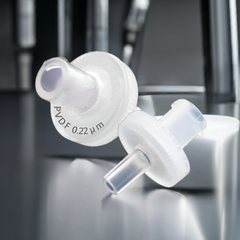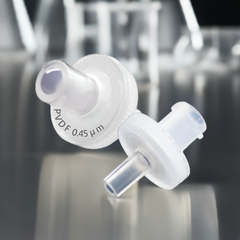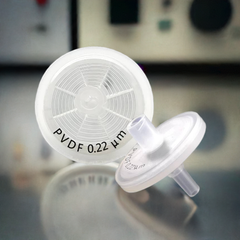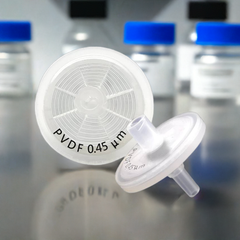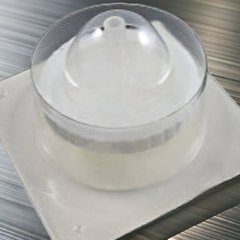Polyvinylidene Difluoride PDVF Syringe Filters
6 productsPolyvinylidene Fluoride (PVDF) Syringe Filters: High-Performance, Reliable Filtration Solutions
PVDF - Polyvinylidene Fluoride syringe filters are a crucial tool for advanced laboratories that seek ultra-clean samples with minimal analyte loss. It happens when a particular substance is reduced in a sample, analysis, or any process. Trusted widely in cell culture, HPC, and ultra-clean samples, our PVDF syringe filters offer superior performance and compatibility.
What is PVDF and Why It Matters?
PVDF is a high-performance thermoplastic. It offers exceptional chemical resistance, mechanical strength, and minimal protein binding.
In filter applications, PVDF excels due to:
- Hydrophilicity: Naturally attracts water, maximizing filtration speed and reducing bubble formation.
- Chemical compatibility: Resistant to alcohols, weak acids, proteins, and biomolecules; ideal for aqueous and mild organic samples
-
Low extractables & UV transparency, crucial for HPLC and UV-sensitive protocols.
Together, these traits make PVDF filters particularly useful for protein and peptide solutions, Western and Northern blot buffers, enzyme media sterilization, and general HPLC and GC preparation.
Hydrophilic vs. Hydrophobic PVDF Membranes
PVDF membranes can be either hydrophilic or hydrophobic, and choosing the right one ensures optimal PVDF syringe filter compatibility:
Hydrophilic PVDF Filter Membranes
- Have an affinity for water, ideal for aqueous, alcohol-based, and biological samples.
- Promote smooth, rapid flow and minimize protein loss.
- Featured in PVDF syringe filters like the 33 mm hydrophilic, branded by SyringeFilter.com.
Hydrophobic PVDF Filter Membranes
- Repel water, better for nonpolar solvents and gas filtration.
- Less common but often available for specialty filtration needs.
When selecting a PVDF syringe filter, aligning hydrophilicity with your solvent system is critical for reliable performance.
Filter Sizes, Pore Options, Sterile vs. Non-Sterile
Size & Pore Variants
- 13 mm, 25 mm, 33 mm diameters.
- Standard pore sizes: 0.22 µm (microbial removal, sterility-centric) and 0.45 µm (particulate removal, GC/HPLC prep).
- SyringeFilter.com offers both sizes in sterile and non-sterile formats.
Sterile vs Non-Sterile PVDF Syringe Filters
- Sterile PVDF syringe filters (e.g., 33 mm packs) are gamma-sterilized, making them ideal for use in tissue culture, enzyme filtration, sterile injections, and sensitive biological applications.
- Nonsterile filters are sufficient for sample preparation and routine laboratory work and are more cost-effective.
Choosing between sterile and non-sterile should align with your PVDF syringe filter compatibility needs and experimental sterility requirements.
Applications & Real-World Uses
PVDF syringe filters meet diverse laboratory needs:
- HPLC/GC sample prep: Prevents column clogging from particulates.
- Protein/PTA/buffer filtration: Ideal for immunoassays, Western/Northern blots.
- Sterilization of biological samples: It is useful for cell culture and enzyme solutions.
- Mobile phase cleaning for chromatography.
Their broad solvent compatibility, fast flow, and minimal protein binding make PVDF filters indispensable.
Compatibility Snapshot
According to the properties of Polyvinylidene Fluoride:
|
Sample Type |
Compatibility with PVDF |
|
Alcohols, ethanol, methanol |
Excellent |
|
Proteins, peptides, aqueous buffers |
Excellent |
|
Weak acids, solvents |
Good |
|
Strong acids, ketones, esters |
Limited |
|
Acetone, DMSO, DMF |
Not recommended |
For strong acids, bases, ketones, or caustic solvents, consider PTFE or PES filters instead.
Product Listing Snapshot
Each filter variant from SyringeFilter.com includes:
- Diameter: 13 mm, 25 mm, or 33 mm
- Pore size: 0.22 µm or 0.45 µm
- Sterile or non-sterile options (33 mm sterile ready)
- Connection type: Luer lock or slip
Sample SKU: “PVDF033S022I” – 33 mm, 0.22 µm, sterile, 50‑pack.
Best Practices & Filtration Tips
- Pre-rinse: Prime filters with solvent to remove air and condition the membrane.
- Discard first 0.1 mL: Ensures consistent sample volume.
- Avoid clogging: Use a pre-filter or glass fiber pre-filter with high particle loads.
- Storage: Keep in a clean, dry environment to avoid contamination.
- Sterile technique: Use sterile gloves and a laminar flow hood when handling sterile filters.
Why Choose PVDF Filters?
- High chemical resistance: Works with aqueous and mild organic solvents.
- Hydrophilic nature: Fast, bubble-free filtration.
- Low protein binding: Ideal for delicate biomolecules.
- Sterile packaging: Ensures microbial-free samples.
- Lab-proven reliability: Widely cited in HPLC prep and blots.
Frequently Asked Questions
What makes a PVDF membrane hydrophilic?
Hydrophilic PVDF filters are treated on the surface to absorb water. It ensures rapid filtration with no bubbles, making it ideal for use with aqueous and biological samples.
Are PVDF filters suitable for organic solvents?
PVDF is compatible with alcohols and weak acids. Do not use ketones, esters, or concentrated acids/bases; PTFE is more appropriate in these cases.
When should I use sterile vs. non-sterile PVDF filters?
Choose sterile PVDF syringe filters when using them in injectable, cell Culture, or microbiology-sensitive applications. Non-sterile is best in general sample prep.
Do PVDF filters bind proteins?
No. PVDF is a low protein-binding component. It binds low-protein samples, thereby maintaining sample integrity, which is crucial for assays such as immunoassays, Western blots, or Northern blots.
Can I use PVDF filters for HPLC mobile phases?
Yes. PVDF reduces UV absorbance, which maintains the performance of HPLC.
PVDF Filters for Precision Filtration
PVDF syringe filters (available in hydrophilic or hydrophobic forms) are valuable solutions to contemporary laboratory processes. They are invaluable because of their strengths in HPLC preparation, protein assays, and sterile sample processing.
Choose about solvent compatibility, size, pore, and sterility requirements. With the help of professional usage recommendations, laboratories can prevent complications such as clogging and ensure the quality of their outcomes.

